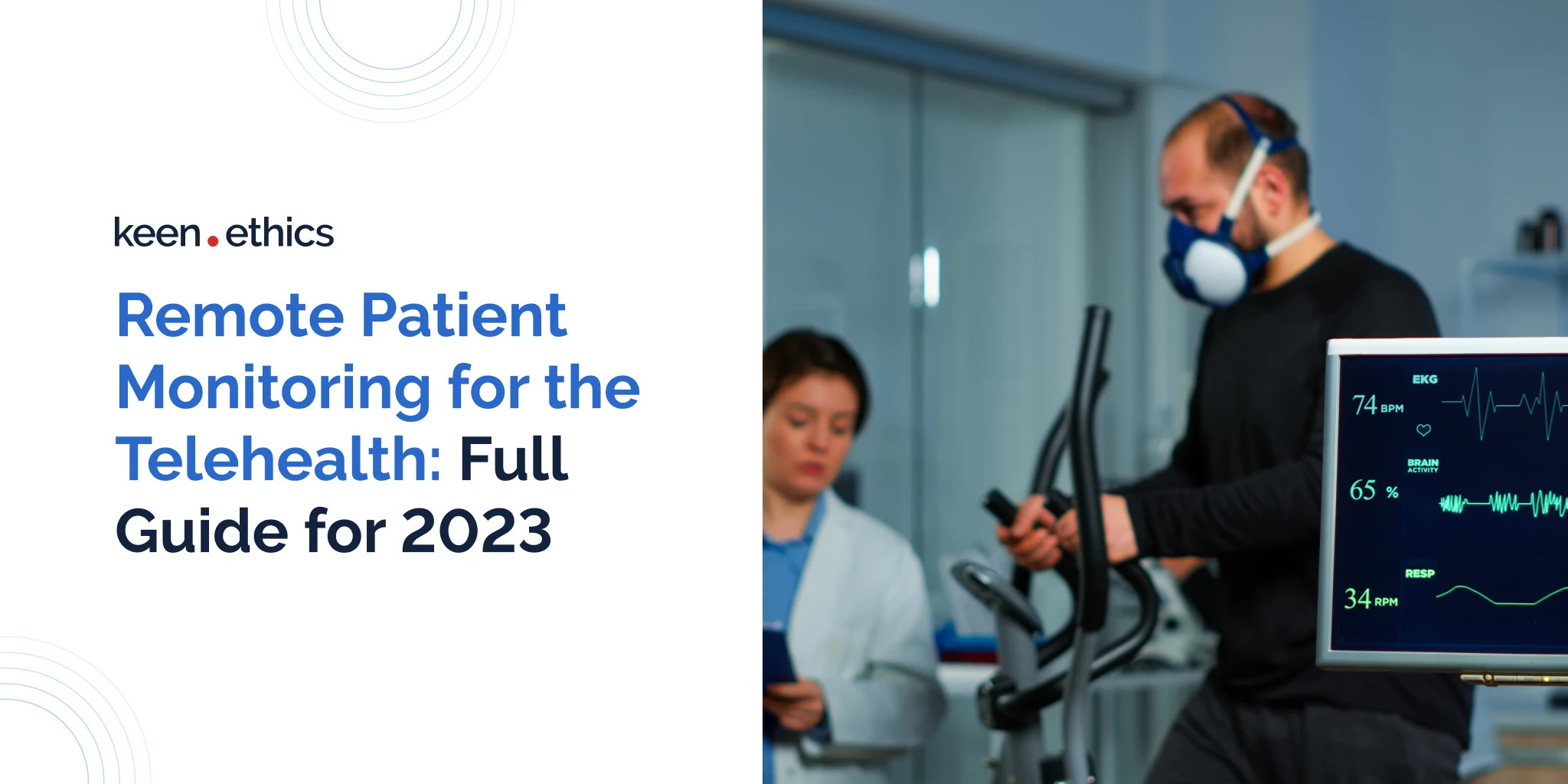Do you want to create a remote patient monitoring tool for telehealth? In this article, we review the key benefits of the technology and the ways to develop it.
Certain diseases are debilitating enough to require constant monitoring, but simultaneously don’t disrupt the ability to perform day-to-day activities. For instance, hypertension requires active observation, but it can have no impact on a person’s everyday life if one treats it properly. What’s the problem with this and similar conditions? Many individuals don’t take them seriously. Self-sabotaging behavior, such as disrupting medication schedules and doses, is a common issue for some patients. Regrettably, many people die yearly due to preventable complications: by ignoring the recommendations of doctors, they undermine their long-term health. According to Jennifer Kim, an American specialist in pharmacy education, and her colleagues, medication nonadherence can account for up to 50% of treatment errors. 125000 people die every year in the U.S. due to this issue. Remote Patient Monitoring is a technology minimizing those concerns. In this article, we’ll review how remote patient monitoring works and showcase the ways to manage this technology.
What is Remote Patient Monitoring (RPM) for the Telehealth?
As we’ve mentioned before, a key problem for treating patients outside hospitals is the inability to control their behavior. Medication alone can’t prevent health difficulties: many chronic diseases result from an irresponsible lifestyle. So, what is remote patient monitoring? As the U.S. Agency for Healthcare Research & Quality notes, Remote Patient Monitoring (RPM) in telehealth allows patients to use special devices at home to collect health data like heart rate or blood sugar levels. The data is then securely transmitted to healthcare providers, who analyze it remotely. After analysis, the doctors can communicate with the patients through telehealth to discuss their health status and address concerns. Why is RPM so important? Firstly, the framework helps patients avoid frequent visits to the doctor’s office. Secondly, it enables timely intervention if any issues manifest. Doctors can intervene if the patients are irresponsible about medicine intake or encounter a crisis due to, for example, significant stress.
How Remote Patient Monitoring Works?
Remote patient monitoring became possible due to the development of the Internet of Things and affordable medical technology. What does it involve? Doctors give patients some devices to wear or even install (for instance, if blood monitoring is essential). These devices then automatically scan the critical aspects related to a person’s health, such as blood sugar (the U.S. Food and Drug Administration approved the first glucose monitoring implant that works via a mobile app in 2018). After that, they send the information about the patients to the doctors via the Internet. Many tools of this kind connect to high-quality software tracking statistics and even provide graphs for the tracked health indicators. Using this information, doctors can modify treatments, making informed decisions about the long-term well-being of a patient. One may contact them regarding their discipline or inform an individual that they need an urgent hospital visit.
Benefits of Remote Patient Monitoring Apps for Patients and Doctors
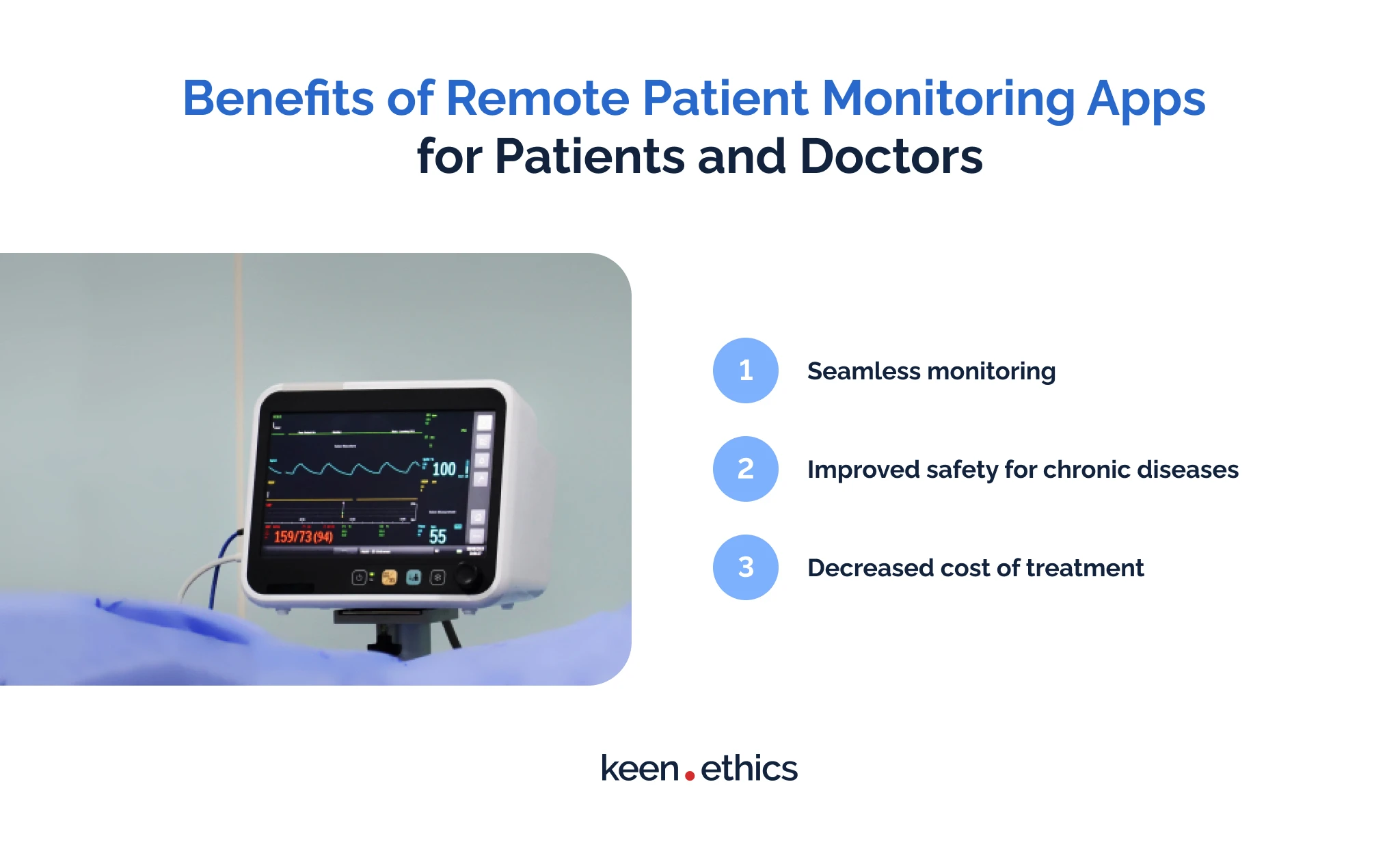
Now that we know remote patient monitoring definition, it’s time to look at the benefits of this technology for the key stakeholders. We’ll review how it can be beneficial for patients and doctors:
Benefits for Patients
The patients get many benefits from the RPM frameworks. Here are the key factors one should consider:
1) Seamless monitoring. A big problem for many individuals is that the monitoring process is distracting. Using blood sugar test kits or blood pressure measuring devices isn’t a time-consuming process. However, it can break the workflow for many people if it’s too periodic. Some procedures are also painful (as in the case of blood sugar tests). RPM devices allow one to automatically perform all the tests, requiring no significant input or minimal interventions. In this way, a patient can work distraction-free for a long time and ensure the lack of any adverse symptoms.
2) Improved safety for chronic diseases. In cases of acute hypertension or type 1 diabetes, the probability of encountering devastating health outcomes due to problems with monitoring is tremendous. RPM devices are notable for their ability to prevent such problems from happening. They can increase the frequency of monitoring due to being non-invasive, allowing one to better understand how a specific disease manifests. Why is this important? More detailed statistics enable the patients to see patterns that may show a path toward upgraded treatment or warn them about potential complications.
3) Decreased cost of treatment. The problem with many chronic diseases is that they lead to expensive complications. Untreated hypertension can end in extreme challenges, such as strokes. The cost of recovering from them is tremendous, creating major pressure on patient and insurance company finance. The aforementioned strokes require between 20000 and 40000 dollars for treatment in the U.S., according to Washington National insurance firm. In this light, RPM systems are a perfect framework for decreasing the burden of chronic diseases.
Benefits for Doctors
And what about doctors? A remote monitoring system can also give them massive long-term advantages:
1) Improved long-term results of treatment. The reputation of doctors heavily depends on their ability to deliver positive patient results. In this regard, RPMs are of interest because they give doctors more control over the behavior of the out-patients. Specialists may find complications early and detect negative patterns related to medicine intake. In this way, they can boost the long-term results of their practice. With high-quality information and greater control over patients, it’s possible to reduce the number of accidental deaths and the ones related to lack of discipline.
2) Improved knowledge of disease dynamics. We have a lot of information on some common chronic illnesses. Nonetheless, our knowledge typically stems from the detailed observations of isolated patients and some long-term monitoring that omits many vital aspects. We lack an understanding of the day-to-day statistics for the involved population. Chronic diseases tend to have unique characteristics in many people. How does remote patient monitoring work? It offers an opportunity to uncover the internal dynamics of many diseases in a genuinely large sample of people. Indeed, we already have a lot of information on various diseases. Using Big Data from RPM devices, we’ll be able to boost the quality and amount of data, allowing better data-driven decisions. With this knowledge, doctors and researchers can better understand pathological conditions and create advanced treatment frameworks.
Key Components of RPM Apps
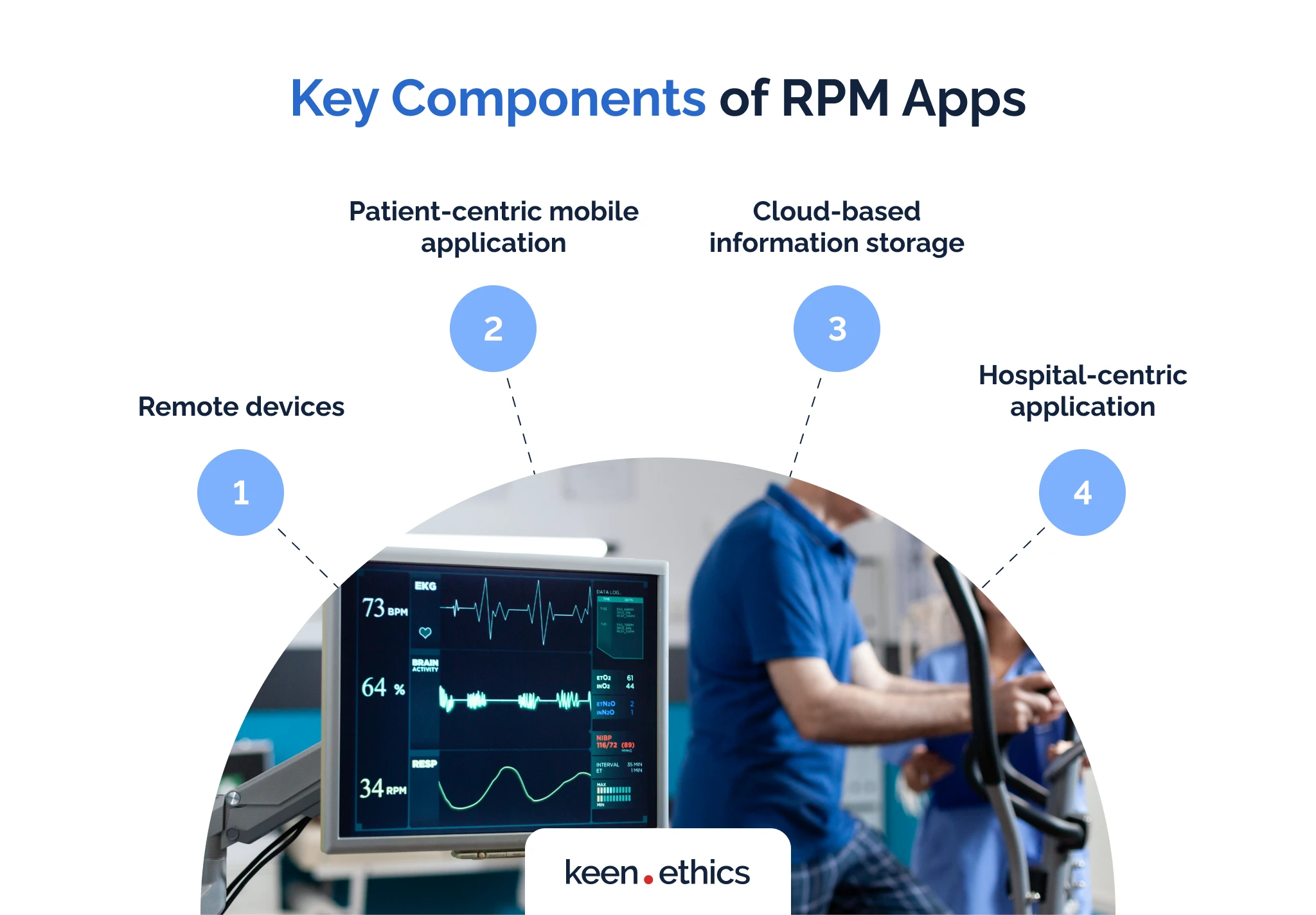
It’s time for us to transition to a full-scale remote patient monitoring software development guide. In this section, we’ll look at the key components of the so-called RPM apps. So, what should one add to make them work?
Remote devices
The first vital aspect for RPMs is the presence of Internet or radio-capable devices. They can include sensors monitoring a person’s blood pressure or the amount of cholesterol in their blood. The ways to install those devices are diverging. In some cases, it’s enough to wear an armband: modern tools allow one to track blood pressure, heartbeat rate, and body temperature. In other situations, one has to undergo a more invasive process. Modern devices for monitoring blood sugar levels are installed within the body. Still, the principle is simple: the device has to, in one way or another, interact with the body of the relevant patient and be capable of sending information to other devices. In the case of RPMs, the usual device of choice is a smartphone.
Patient-centric mobile application
An RPM device usually sends the data to some smartphone. To guarantee a sleek design, adding strong information transmission capabilities is often impossible. RPM devices typically send information within a limited range. The key component is a smartphone app receiving information from monitoring devices. This factor is crucial for two reasons. Firstly, the relevant devices give data to the users, informing them about the current status of their health and the overall trajectory of disease progression. Smartphones have great visualization features that can help us present the key data in a format understandable by patients without advanced knowledge in the healthcare field. Secondly, mobile apps use the Internet to send information to specialists.
Cloud-based information storage
Mobile apps send the data to cloud-based storage, which can preserve tremendous amounts of information. The element is also crucial for another reason: while it’s easy to store numerous types of statistics on hospital-wide PC networks, this method is far from being the safest. Cloud storage ensures that the user data won’t be lost. Moreover, it offers many layers of security for the clients, lowering the possibility of data loss due to component failure. Many cloud-based storage services offer simple tools for integrating HIPAA (Health Insurance Portability and Accountability Act) and PII (Personally Identifiable Information) data protection.
Hospital-centric application
The final element to consider in any remote monitoring system is an app for doctors. This application is likely to be much more advanced than the user-centric one. Firstly, it must feature information about multiple patients. This means the statistical tools, for example, tend to be much more complex. Secondly, the statistics regarding the users must also be more advanced in this case. It’s not enough to know about the person’s heart rate. The patterns in heart-related behavior reveal much more than a simple heart rate analysis. Generally, this app aims to deliver as much advanced data as possible. With this information, one can perform high-quality analysis and deliver services that prevent long-term health damage for patients.
Remote Patient Monitoring Software Development Process
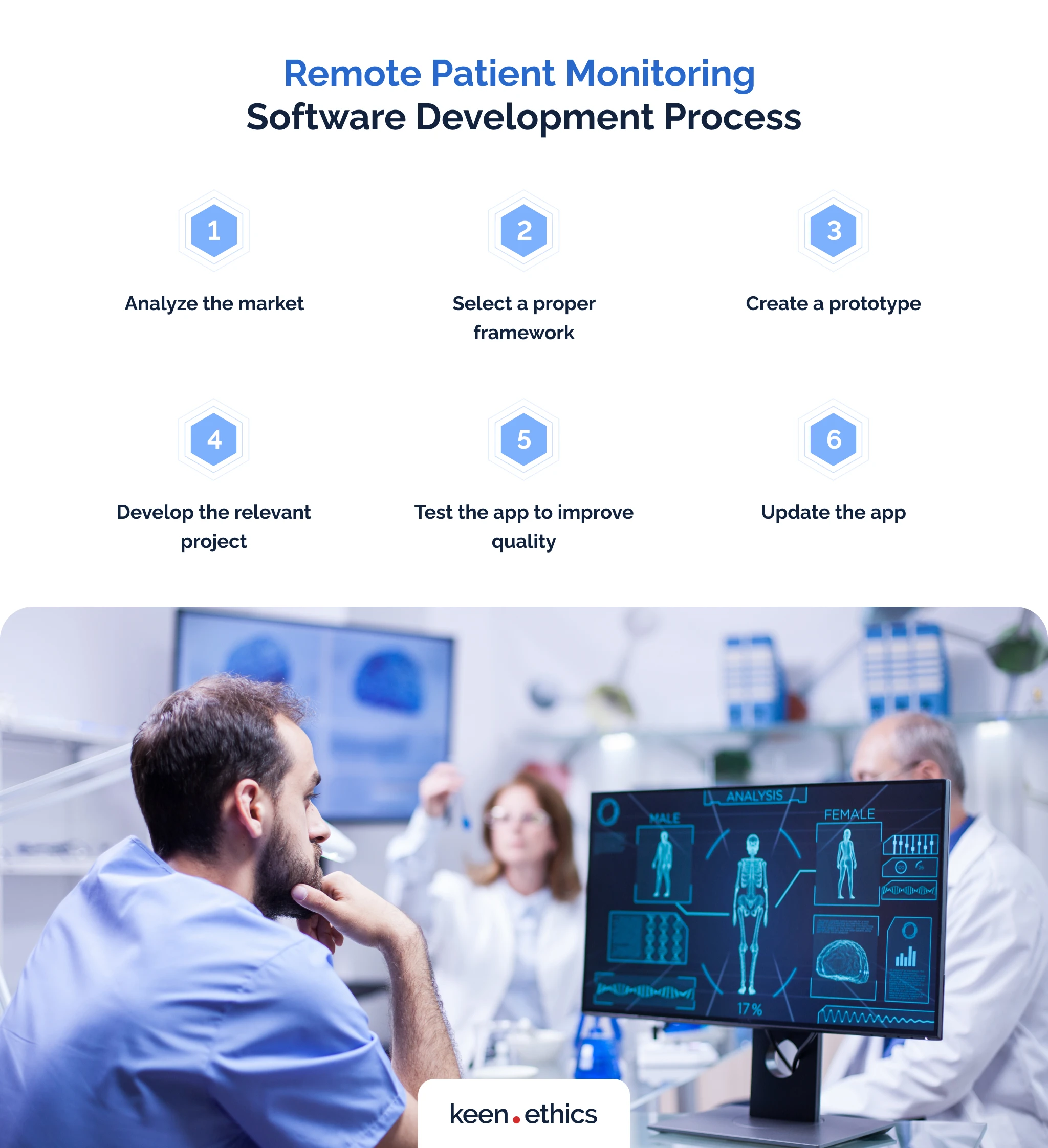
What are the steps necessary for delivering advanced solutions to patients? Here’s our guide to remote patient monitoring:
Step 1: Analyze the market
The first step for creating good patient monitoring software is studying the market. You should review the existing solutions and see if there’s some niche that your hypothetical app can target. What’s our recommendation for this stage? Creating products mimicking the functions of other solutions on the market is illogical unless you deliver a genuine improvement. There are two situations in which we recommend investments in the RPM sector. The first one is the presence of significant flaws in the products of particular competitors. In such a case, direct competition with them makes sense. Another reason for investments is the absence of solutions satisfying your unique needs or the specific requirements of a particular client group. The best way to achieve success is via competition in a niche.
Step 2: Select a proper framework
RPM systems depend on the quality of code much more than traditional medical devices. Problems with a tech stack can end in data loss and incorrect results. In our opinion, devices relying on the Internet to such a great extent also require investment into the tech stacks that target the Internet. What are some great options? Frameworks such as Node.js are among the best solutions for creating a reliable tech stack for the user app, cloud-related backend, and doctor dashboard. They work well with modern browsers and have advanced optimizations for processing many connections.
Step 3: Create a prototype
Before going for full-scale development, performing a ‘sanity’ check on your idea is crucial. The American Bureau of Labor Statistics notes that 20% of businesses fail in the first year. By year five, 50% of businesses fail. How to avoid this? Test your idea. Create an approximate version of the app and device you want to deliver. This approach will help understand if the concept is viable at all. What should one do at this stage? We recommend creating a proof of concept for an RPM device, wireframing the user interfaces, and, more importantly, creating a minimum viable product before proceeding with full-scale development. Many ideas are great on paper, but few survive reality. Testing is the best way to ensure the long-term success of your project.
Related Services
MVP DEVELOPMENT COMPANY
Step 4: Develop the relevant project
Once you know your project makes sense regarding general and specific ideas, it’s time to start full-scale development. What remote patient monitoring guidelines for developers can we offer here? Select a team combining both IT specialists and medical experts. A good healthcare software project always combines expertise from multiple sectors. Another vital aspect to consider is the experience in both development and healthcare development by itself. Not every talented developer will be good for your business specifically. Specialization is crucial for success.
Step 5: Test the app to improve quality
Testing is central for all apps. However, a bug in a video player, for instance, is forgivable. It will only influence the entertainment-related aspects of a user’s life. The situation is different for the healthcare sector. A bug in the RPM software can sometimes be fatal. For example, if the blood sugar monitoring app provides an incorrect result, there’s a risk of creating a false sense of security in a patient. Dexcom glucose monitors provoked major injuries among their users due to failed audio systems. An incorrect result can force them to delay an ER visit, resulting in massive damage to their health or even death. For this reason, RPM frameworks require investments in more testers than in the usual scenario. You should be prepared for increased security investment to create healthcare software.
Step 6: Update the app
No amount of prototyping can reveal all the issues with a particular RPM solution. It’s possible to anticipate the potential problems of the patients, indeed. Still, our biology and psychology are complex enough to create some unexpected outcomes. This means development doesn’t end with a release of a product. You must gather feedback and then update the hardware (RPM device) and the software. Without this, there’s a risk of encountering life-threatening bugs (even the most thorough testing can miss some interactions) and discouraging the users from trying your app due to the low-quality interface. In the RPM field, development doesn’t end with a release: you have to constantly strive to make the product more patient-friendly to address the newly arising problems.
Custom Remote Patient Monitoring Software Features
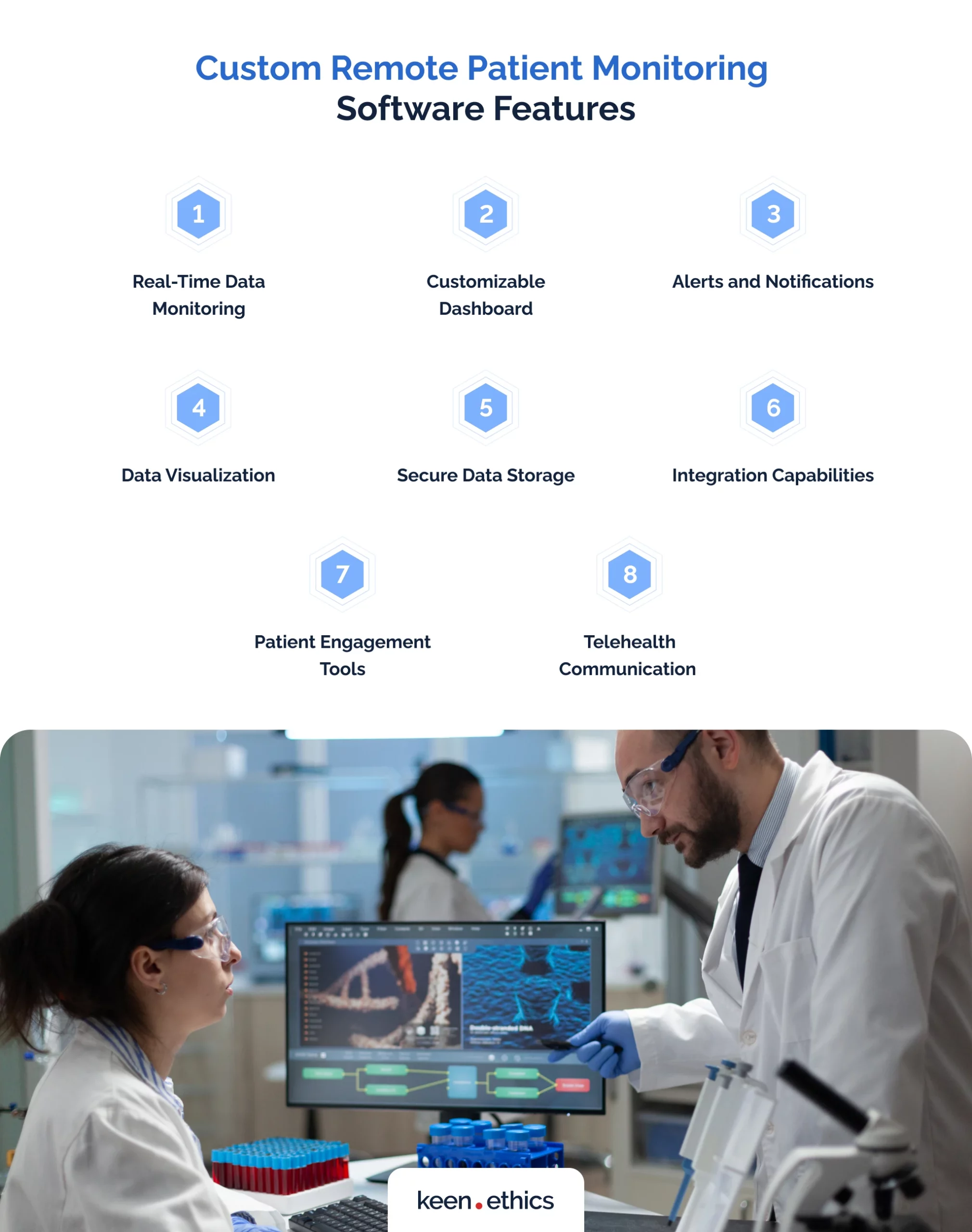
A vital part of any guide to remote patient monitoring is the description of the functions essential for the users. Here are eight potential features that may be relevant for custom RPM software:
Real-Time Data Monitoring
One of the main advantages stemming from modern RPM devices is that they allow one to maximize the number of measurements. A ‘traditional’ blood pressure measurement device can offer more or less uninterrupted data analysis only if one constantly monitors the patients. Obviously, such an approach is inconvenient for both doctors and patients. RPM devices allow one non-invasive data tracking. A fitness band, for example, can measure blood pressure every minute. The measurements are not as accurate as in the case of blood pressure monitors, but they can nonetheless offer viable information. This approach allows one to continuously monitor and collect patient health data from various devices and sensors. In the end, the data becomes real-time or at least close to this (for example, the intervals between measurements may be 5 to 10 minutes). Such an approach allows for collecting a maximum amount of information regarding the patient and making decisions based on the recent state of a person.
Customizable Dashboard
Due to collecting a lot of information, RPM software can overwhelm the user with the amount of data. To ensure long-term comfort for the patients, it’s essential to establish a comfortable presentation of the user data. What should you do in this regard? We believe one must deliver a user-friendly dashboard for healthcare providers and even patients to view and analyze patient data at a glance. A dashboard must feature high-quality graphs and have a customizable interface, allowing the users to track vital information regarding a particular case.
Alerts and Notifications
What’s another crucial feature for doctors (and even patients)? You should set up customizable alerts and notifications to notify healthcare providers of critical changes or abnormalities in patient data. It’s not uncommon for RPM software to collect data on dozens, if not hundreds, of patients. In this light, the absence of notifications can lead to doctors not noticing some crises. Notifications are vital for key users because they lower their anxiety regarding negligence-related errors and decrease the amount of monitoring one has to perform.
Data Visualization
As we’ve mentioned before, RPM frameworks collect a lot of data. Some pieces of it tend to be more critical than others. If you don’t provide a good presentation format, however, finding the key data in a ‘sea’ of different characteristics would be difficult and even close to impossible. So, what should you do? Present patient data in visually appealing charts, graphs, and trends for straightforward interpretation and analysis. You should also offer an option for setting up data priority: the users must be able to choose which information is central for them and which isn’t.
Secure Data Storage
Ensure robust data security measures, including encryption and HIPAA compliance, to protect sensitive patient information. The data from RPMs can sometimes be used against the patients. A revelation that a patient has cancer can result in them being fired from some job, for example, because the managers see the worker as ‘unreliable.’ While this is illegal in many countries, government corruption can make it impossible to sue business owners. Euronews reports that many countries feature corrupt labor laws. The more security you deliver, the better.
Integration Capabilities
RPM data offers a significant amount of vital information for tracking the health of the patients (especially if support to industry-wide medical interfaces such as HL7 is present). For instance, minute heartbeat data can be crucial for establishing a diagnosis. This means integrating with Electronic Health Record (EHR) systems and other healthcare software for seamless data sharing, and interoperability is important. Data from RPM devices can be available within an isolated app, which isn’t accessible to all doctors. Integration into the Electronic Health Records (EHR) frameworks solves this problem. Since one can access information from them in multiple hospitals, RPM data becomes easily shareable, reducing the need for complex paperwork.
Patient Engagement Tools
A big aspect of all RPM systems is offering high-quality insights for patients, too. Improved understanding of their chronic diseases can make people more responsible about their management and alleviate anxiety regarding some conditions. What are some key features one should consider here? We believe the developers must include patient-centric features like reminders, educational resources, and interactive tools to encourage active participation in their care.
Telehealth Communication
RPM is notable for its ability to provide detailed information about patients without hospital visits. Telehealth is central for capitalizing on this feature. Why? It enables users to consult doctors without leaving their homes. If the condition is stable enough, online consultation is sufficient to ensure the long-term success of treatment. How should this feature look to succeed? We believe the developers must enable secure video calls, messaging, and audio calls within the software. This approach will ease virtual consultations between patients and healthcare providers and fit diverging communication styles.
Is this list complete? Most likely, no. Remember, these features can vary depending on the specific requirements and goals of your custom RPM software solution. But, the majority of RPM systems benefit from them.
How Much Will an RPM System Cost?
The cost of a remote monitoring system varies depending on factors such as the complexity of the software, the number of features, integration requirements, and vendor pricing. It’s advisable to contact RPM solution providers for accurate pricing details tailored to your specific needs. Generally, small solutions can start from small prices: they can cost between 15000 and 20000 dollars. Large-scale ones, however, can go into millions of dollars. Many things depend on labor costs too. Development in Europe or America is likely to be more costly than in, for example, Eastern Europe or India. In the case of Keenethics, the rates per one hour of developer’s time are between 25 and 50 dollars (depending on expertise and task complexity).
Conclusion
All in all, investments in remote patient monitoring software are worthwhile. This technology solves many problems encountered in the healthcare sector. It lowers medication non-compliance and offers strong insights into diverging chronic diseases. In the end, the relevant innovation boosts the quality of life for the patients. Are you dissatisfied with existing solutions on the market? In that case, contacting us is a great idea. Keenethics develops custom software that targets the unique needs of partner companies. You’re welcome to review our portfolio here.
FAQ
What should I know while developing an RPM?
While developing a Remote Patient Monitoring (RPM) system, it’s essential to consider factors such as data security, compliance with regulations, interoperability, and user-friendly interfaces.
What chronic diseases can benefit from RPM analysis?
Chronic diseases such as diabetes, hypertension, heart disease, chronic obstructive pulmonary disease (COPD), and obesity can benefit from RPM analysis.
What health improvements can I expect from RPM frameworks?
RPM frameworks can lead to improved health outcomes, including better disease management, early detection of health issues, timely interventions, and enhanced patient engagement.
How to integrate telehealth and RPM?
To integrate telehealth and RPM, healthcare providers can utilize separate telehealth platforms or software that allow for remote patient monitoring and virtual consultations. Developing internal solutions for RPM software is also a good choice in many situations.
Contact us to get a free estimate for your product!

